Brushing a cat is not often practiced by cat owners, except for those who own a long-haired cat, but it is an essential part of your pet’s care. This guide will help you discover the benefits of brushing, but also its essential steps and the equipment to use to take good care of your pet.

What are the benefits of brushing your cat?
Taking care of your cat’s coat
With the arrival of spring, all cats begin their moulting period, in other words, they lose their hair, thus refining their coat. Brushing your cat will remove this dead hair.
But, outside of the shedding period, brushing your cat also smoothes its coat, making it shiny and waterproof, which is especially important for outdoor cats.
Avoiding hairballs
Cats are certainly the cleanest of all animals, grooming themselves daily by licking. However, its raspy tongue catches the hair which, if not eliminated by a preliminary brushing, is swallowed. These hairs then form balls in the stomach of cats, which can cause digestive problems, vomiting and even lead to intestinal obstruction in the worst case scenario.
Promote the relationship with your pet
Brushing is a moment of complicity and sharing with your cat. Get your cat used to being brushed from a young age, so that he appreciates this act and does not experience it as a pleasant experience. With your free hand, caress him a lot: he will let you do it all the more. He’ll enjoy the petting and you might even catch him purring. During this time of relaxation, you’ll have plenty of time to inspect his coat and skin, in order to detect any redness, parasites or wounds that need to be treated.
What accessories should I use to brush my cat?
Depending on the type of hair your cat has, brushing will not be done with the same equipment or at the same frequency. Indeed, if a long-haired cat needs daily detangling, a short-haired cat will be satisfied with a weekly brushing.
Tools for a shorthaired cat
For a short-haired cat, such as a Siamese or an Oriental, choose a comb with narrow teeth, which can pick up dead hair. However, you may prefer a rubber glove or natural hair glove, used for massages, much more comfortable for your cat than the teeth of a comb that he would feel on his skin. Finally, adapt the material according to the pleasure your companion takes during this moment.
The essential equipment for long-haired cats
For a cat with medium or long hair, such as the Persian or the British Longhair, the work is more substantial. Choose a wire brush with long and flexible teeth, a currycomb, but also several combs whose distance between the teeth differs a little. You’ll need to juggle these different accessories to effectively brush the layers of the coat.
Daily brushing is essential for these cats to avoid the formation of knots that, in the long run, can only be removed with a pair of scissors or clippers.
Finally, beyond the material used, choose a quiet place to proceed to this care in all quietness and without generating too much stress to your companion.
The steps of a good brushing
Brushing your cat is an art that must be practiced step by step, the key being to be gentle and delicate so as not to rush your cat.
Whatever the type of hair, the comb should be used in the direction of hair growth. The soft brush can be used to brush back the hair, afterwards, in order to remove all the dead hairs.
On long hairs, proceed from the widest to the narrowest, using wide-toothed combs for dense areas such as the hindquarters or the base of the tail, and a finer-toothed comb for more sensitive areas such as the top of your cat’s legs or belly.
For sensitive areas, such as behind the ears, around the nipples or on the chin, use a soft brush, which is less aggressive than a comb, but will help prevent tangles from forming in these areas.
Finally, if the cat is naturally clean, a bath can be beneficial in order to fight against parasites or hair that tends to get greasy. As with brushing, it’s best to get your cat used to showering from a young age, usually two to three times a year. To do this, use a shampoo that is suitable for animals. If your cat is afraid of water, it is also possible to use a dry shampoo, in the form of a foam to be massaged on the hair, in order to restore the shine to its coat.






